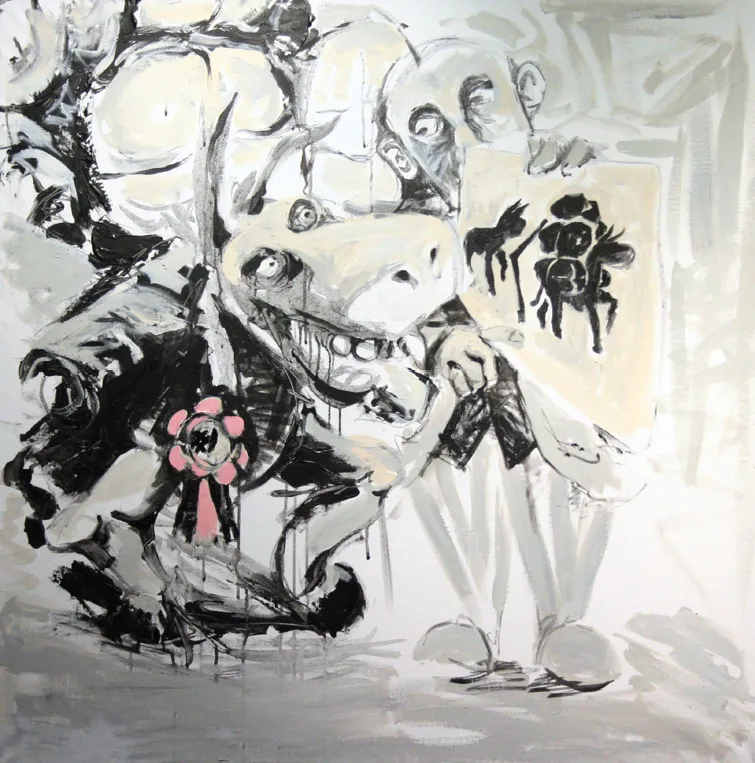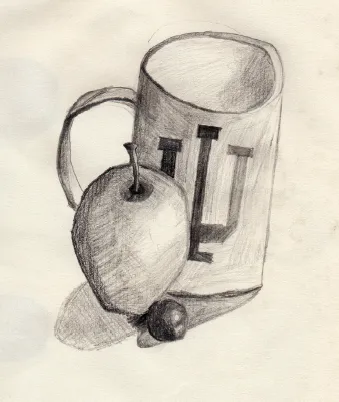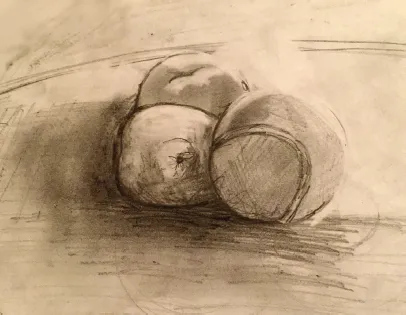![]()
1 · Lessons in Drawing Realistically
Very young children typically are free and open about the process of art making. For these young artists, art making is an act of gestural play, an exploration of media, and an expression of immediate emotions and ideas. There is little concern for or attempt at realism; a child’s art making is expressive, idiosyncratic, individually and socially symbolic.
When adolescents or adults return to art making, much of the playfulness has been forgotten. Older would-be artists have been conditioned to experience visually realistic representations as art. Therefore, older students who return to art making after a hiatus of several years may want to learn basic rules of creating realistic art in order to develop or re-awaken confidence in their artistic abilities. The lessons in this section offer choices of subject matter, techniques, and traditional media for realistic drawing. Students are introduced to ways of observing real objects in space and are provided instructions on how to translate what they see into competent visual images or artifacts. Through the stimulation of ideas that spark emotional expression and invite experimentation with traditional approaches, the lessons in this section will encourage students to rediscover art making as a playful adventure.
FEATURED ARTIST: BRIAN CHANGRAI CHO
Brian Cho’s interest in art making, which evolved from early childhood experiences of doodling on paper, was honed by art classes in elementary school while living in South Korea, then through high school art classes in Charlotte, North Carolina. Eventually he received a Bachelor of Fine Art (BFA) degree from the School of Visual Arts in New York and both a Master in Fine Arts (MFA) degree and a K–12 Visual Art teaching certificate from Indiana University, Bloomington. Several works by his students are included in this text.
In his work, Cho attempts to create a visual reflection of a narrative situation or context. Once an idea or story comes to mind, he begins to transfer the conceptual imagery in his mind to canvas.
When I am painting, I ask myself two questions. First, I ask, “Is my image effectively representing the idea intended?” Since my paintings are visual narratives, it’s important that viewers are able to determine what the painting is about. I would like viewers to read the dialogue of my paintings from studying the imagery without relying on any verbal or textual explanations. Second, I ask, “Is my painting aesthetically appealing?” Creating a visually appealing artwork is just as important for me as creating a conceptually interesting work.
Brian Cho’s painting describes an overworked donkey receiving praise and pampering from an owner, who keeps him working under unreasonable conditions by assuring him that he is a “superior donkey” for doing such hard work. Dumb Ass, 2015. Acrylic and gesso mixed media on canvas, 30" × 30". (Courtesy of the Artist)
Lesson 1: Shading Rounded Objects
Have you ever tried to draw a ball, cylinder, or human body? These shapes have surfaces that are concave (curved inward) or convex (curved outward); their surfaces are rounded rather than flat. Light and shadows define the three-dimensional form of rounded objects. When light hits a curved surface two effects result: the part closest to the light source will be very bright, while the part farthest from the light source will be darkened. Unlike a flat-sided object, where shading may change sharply from one angle to another, on a rounded surface the shading seems to change gradually. In this lesson, you will look closely at a group of rounded objects to examine how light falls on these kinds of surfaces. Additionally, you will notice how shadows fall when an object closest to the light overlaps and blocks light from falling on another object. You will describe what you observe by drawing those areas of light and shadow that define a still life.
William Kennedy, Rounded Objects, 2012. Pencil on paper, 12" × 9". (Courtesy of the Artist)
Megan Newcomer, Drawing of Rounded Objects, 2015. Pencil on paper, 9" × 12". (Courtesy of the Artist)
INSTRUCTIONS
1. Arrange a group of curved or round objects into a still life composition. Some objects should be placed in front of others to create a visual overlap.
2. Make sure the light illuminating the objects comes from a strong single source, such as a floodlight, flashlight, or reading lamp. Dim all other lighting and pull shades or curtains to block diffused daytime lighting.
3. On a 9" × 12" sheet of white drawing paper, draw the contour shapes of the objects in the grouping you have arranged.
4. Check your drawing for correct proportions of one object to another.
5. In order to show clearly what happens when the rounded objects are lit by a single light source, note the following:
a. Use various soft and hard lead pencils to show gradations of light to dark.
b. The small section of the rounded object that directly faces (and is therefore closer to) the light source will be lighter than the parts of the object that fall away from this point.
c. Very few parts will be completely black (no reflected light) or white (maximum reflected light).
d. Most surfaces will reflect some lesser or greater gradations of shading.
e. Pay attention to shadows under the rounded objects and to places where shadows overlap each other.
6. Draw objects that are close to you in greater detail than those that are farther away.
Materials Needed
white drawing paper, 9" × 12"
drawing pencils with soft and hard leads
eraser
assorted found objects with rounded forms
Vocabulary
Composition
Concave
Contour(s)
Convex
Cross-Hatch(ing)
Form
Gradation
Overlap
Proportion
Scrumbling
Shade/Shading
Still Life
Stippling
Three-Dimensional
Visual Texture
WHAT TO SUBMIT FOR EVALUATION
· a drawing of a group of rounded objects with overlaps, lit from a single light source, with gradations of shadows
LESSON EXTENSION
Study how shadows affect dark- or light-colored objects and reflective or matte surfaces differently. As a lesson extension, try drawing a still life of objects with dark and light or matte and reflective surfaces. After completing the drawing, add touches of color to some of the darkest areas of the drawing with colored pencils or watercolors. Does color alone change your perception of depth and volume? If so, how? What role do light and dark play when combined with color?
TIPS FOR TEACHERS
Applications for Teaching Pre-K–6 Students
The shading of rounded objects is demonstrated by the relationship of planets to the sun. When a planet or moon is facing the sun, it is illuminated. Its opposite side is unlit and thus dark. When our planet faces the sun, we experience daytime; when it turns away from the sun, we experience night. Planets that have atmospheres, such as the earth, will move somewhat gradually from light to dark, because the atmosphere diffuses the light along the edge of the earth that is moving into darkness. This also happens to objects we view here on earth. Students may begin to understand how rounded objects are shaded if they are invited to create images of planets in the solar system as these might be seen from space.
At night, when we see the side of the moon that is lit by the sun, the reflected glow of moonlight casts a pale light on objects below. Students can study this effect by drawing pumpkins or other rounded objects as they would appear in the light of a full moon.
Anonymous, The Pumpkin Patch at Midnight with a Full M...




